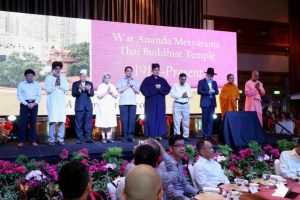
Introduction
Koan is a Chan case study that is to be intuitively contemplated to awaken Gnosis. It may be formatted in the forms of story, dialogue, question and statement. Gnosis is self-discovery of the Buddha-nature in Man. Hua-tou is the crystallized Dharma essence of Koan. It is the soteriological critical doctrinal point derived from a Koan. It is utilized to pierce the veil of false self through one-pointed concentration to unveil the Essence of True Self. In the Gnosis process, the mind travels from realm of duality to the realm of the Awakened breakthrough of Non-duality. The Essence of the True Self is Buddha-nature. Self-knowledge kills self-centric ego, delusion, illusion, or conceptualization. It helps the Chan practitioners to transform intellectual thinking into intuitive contemplation. It is a tool to help a Buddhist practitioner to let go habitual object-reifying attitude of grasping or clinging immediately. Generally put, it is using intellectual and intuitive wisdom to kill ignorance of the Essence of Dharma (Dharmasara). Sentient beings know more about the external world (macrocosm) rather than their inner world (microcosm). Ignorance of the inner world is the root of troubles of mankind – societal conflicts, national instability, regional confrontations or even clashes of civilizations internally or globally.
A Huatou is an effective or poignant head or crux of Chan saying. It is an effective expedient devise (upaya) to annihilate rational thinking of duality. It paves the way to intuitive contemplation through which breakthrough of Insight is actualized. It opens the inner Heart and self-manifest the Dharmakaya (Truth Body). The following are some of the popular Chinese Chan Huatous that can be contemplated upon.
1.Who am I?
2.What is your original face before you were born?
3. Who is that which is preaching?
4. Who is reciting the name of the Buddha?
5. Does a dog have a Buddha-nature?
For those who have already developed intuitive wisdom of self-knowledge, this Chan pedagogy of Koan or Huatou is not an appropriate methodology. It does not create a great doubt in them, as they already know the appropriate answers intuitively and not intellectually. Intellectual understanding of Sadharma is not yet a soteriological arrival or Gnosis completer. From a modernist perspective many of these Koans or Huatous might prove to be too abstruse for them to practice. Therefore, Koan or Huatou pedagogy is not suitable for all Buddhist practitioners. Nevertheless, they are effective for readied Chan practitioners.
Suitability
The Koan or Huatou pedagogy is only appropriate for those Dharma practitioners who immediately develop a great doubt after the Master has presented a Koan or Hua-tou for his or her contemplation. Koan or Huatou pedagogy is only pertinent to a Chan learner who is fully prepared to strive hard to kill conceptual thought of duality and develop the intuitive wisdom of Non-duality. The soteriological goal is to transform the ordinary sentient Eye of flesh and mind into the Dharma Eye of Intuition. The tool of Koan or Huatou is to partake of the Chan practice without the Scripture in process of training. After training, scripture ought to be referred to for measurement and self-evaluation of spiritual progress. A Koan or Huatou directly points to the mind to discover the Buddha-mind of the inner Heart. The Buddha-mind dwells in the inner Heart. The inner Heart is the Embryo or Womb of Tathagata (Tathagatagarbha). The self-discovery of Tathagatagarbha self-manifests the Dharmakaya. Dharmakaya self-manifests Nirvana. Nirvana is the One Mind of the Buddha-mind. The Buddha-mind is the Dharmakaya of One Mind in three contemplations (Imagination- Non-duality- Middle Path).
Three-fold Nature
Imagination is the state of the mind of sentient beings deluded by the illusions of the multiplicity of the world. The multiplicities of the myriad things in the mundane obsess and defile the mind of a sentient being. Upon realizing the illusions of the world like mirage, magic, echo, mist, bubbles, and flashes of lightning, he dwells in the realm of Non-duality or Emptiness. In the Realm of Non-duality or Emptiness, he realizes the dependently originated Unity of the knower and the known. This is the state of deconstruction of phenomena. Having realized Non-duality, he abides in the perfected realm of the Unity of Duality and Non-duality. This is the reconstruction state of Middle Path of the One in the many and the many in the One (Platform Sutra of Sixth Patriarch; Avatamsaka Sutra).
Functions
Hu-tou is used in Chan practice with two-fold objective of self-actualizing self-knowledge. Firstly, it is an object of meditation to tranquilize dispersed ordinary ‘monkey’ mind. In addition, it serves as a Doctrinal matrix of ultimate Truth of Consummated Nature (Parinispanna-svabhava) of the empirical world to be contemplated upon until the breakthrough in Gnosis is made. The Gnosis breakthrough unlocks the Absolute Reality of what Man or world really is. What Man or world really is Suchness (Tathata) of Reality underlying appearance. Secondly, Koan or Huatou is used by the Chan Master for engaging a soteriological dialogue or interview with his spiritually readied disciples.
Same Vessel
We should NOT misconstrue the Koan or Huatou of Chinese Chan tradition of a newly created Buddhology distinct from standard Buddhist tradition. Buddhist practices may differ but the Principle of Dependent Origination and the goal of actualization of Nirvana are common to all Buddhist traditions. Chan exoteric strategies of pedagogy may differ from Theravada tradition. When we look closely into Chan meditation based on a Koan or Hua-tou, we can also identify the integration of tranquility meditation and Insight meditation in Chan practice of meditation. The underlying principle of practice cannot be different. Every human being is the unity of the five aggregates or the eighteen elements. The soteriological mechanism or spiritual engineering cannot be distinct among all human beings. A Huo-tou itself is an object of mediation that calms and concentrates the mind before the Gnosis breakthrough occurs. The utility of Hua-tou to penetrate into the Essence of the Buddha-nature is the actual Insight meditation. Hence, the mental purification process of tranquility-Insight meditation remains unaltered and intact.
In the Vipassana meditation of Theravada tradition, the three universal characteristics and the Four Noble Truths may be considered ‘Koans or Huatous’ (Doctrinal essences) to be contemplated upon until a Gnosis breakthrough occurs. The body, feelings , thoughts and phenomena are the natural ‘Koans or Huatous’ to be contemplated upon in the Vipassana meditation. Chan wisdom is Vipassana, Vipassana is the One Vehicle leading to liberation for both Theravada and Mahayana traditions. The distinction lies in the varying degrees or depths of Insight into the Insubstantiality of the five aggregates or eighteen elements. The varying depths of spiritual maturity produce different categories of Tathagatas in terms of Arahant (disciple), Self-Enlightened One (Paccekabuddha) and Wisdom Being (Bodhisattva). The Completer of supremely, unsurpassed Enlightened One is the Buddha. Relatively put, A Buddha scores 100 marks for Wisdom and another 100% marks for Compassion. Bodhisattva is less superior to a Buddha but is more superior to Paccekabuddha and Arahant and so forth. Nevertheless, the inherent potentialities to become a Buddha are the same for all human beings.
Esoteric insight unveils that all human beings are equal before religion. Therefore, all human beings are potentially and equally holy and sacred. The Buddhist Ten Superior Precepts (Dasasilas) are like the Prophet Moses’ declaration of the Ten Commandments. It demands that all men should mutually respect each other through non-transgression of the 1948 UN’s Universal Declaration of Human Rights (UDHR). The Western political ideology of democracy and respect for fundamental human rights are originally inspired, sourced and derived from the Ten Commandments. When we look closely into the Ten Commandments, they do not differ in context and essence of the Ten Buddhist Superior Precepts. All core human moral values are included in the Ten Commandments or Precepts with universal application. All UN’s member nations unanimously consented to its implementation since its inception in 1948. They are the moral or ethical roots to sustain the global Order of stability and harmony. UDHR sanctifies secular politics. It ought to be welcome by all in this troubled world afflicted with religious bigotry, racial extremism and terrorism.
Tathagatagarbha
Stereological, the utility of Koan or Huatou is to obliterate duality and to redeem Non-duality to dwell in the One Mind of the Absolute One. In fact, all divergent Buddhist practices are orientated towards the resurrection of the intuitive mind of Non-duality. The intuitive Mind is the One Mind of Self-Awakening. The One Mind is Truth Body or Spirit of Truth (Dharmakaya) of a Buddhist Gnostic. Metaphorically depicted, the double-sided coin is turned over from the defiled ordinary store-house consciousness (alaya-vjnana) into pure Tathagatagarbha Consciousness of Dharmakaya. Dharmakaya is the liberated Principle, Spirit or Life of a Tathagata (Tathagatagarbha: Lankavatara Sutra; Parinirvana Sutra; Shurangama Sutra; Sri Mala Sutra; Lotus Sutra). Dharmakaya is the Truth Body. Tathagatagarbha is the primordial salvific nature of the Lord. The self-explicitation of Tathagatagarbha is Dharmakaya. Dharmakaya is the Spirit-Truth of Non-self, which is the Interbeing of conditional relations of Dependent Origination.
Conclusion
Besides the soteriological benefit of liberation, the knowledge of Tathagatagarbha informs us that Man charts the course of his own life and determines its destiny if he responds to the Truth. Most importantly, if Man drifts away from the Truth, his life would be wrecked with suffering. Before the every sentient being knows his or her Tathagatagarbha, every Buddhist is prescribed with Ten Superior Precepts (Dasasilas) to restrain themselves so that one is not wrecked morally before soteriological arrival. The Buddhist Precepts help the Buddhist learners to embrace the Sadharma to sustain the Dharma Wayfaring of travelling-travelled-travel. Mere Buddhist scholasticism does not suffice. Precept keeping and Mindfulness practice sustain the progressive continuity of Buddhist journey of traveling-travelled-travel before one becomes an unconquerable victor unconquered by forces of defilement.








